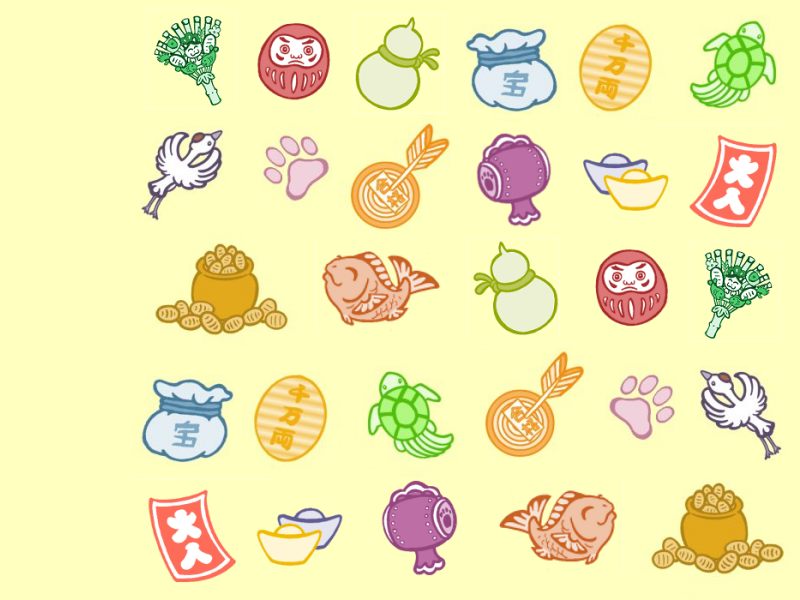ShopDreamUp AI ArtDreamUp
Deviation Actions
Suggested Deviants
Suggested Collections
You Might Like…
Featured in Groups
Description
This wallpaper was created for my Maneki Neko website. [link] The crane, tortoise, money sack, and hammer were based on the embroidered images on Marl, my dancing matsuri neko. The koban coin and pot of coins were redrawn from lucky cat stickers I bought. The rest of the images are original designs by me. All of these items have been associated with lucky cats.
Here's what they all mean:
(First two and half rows, left to right, top to bottom)
Kumade lucky rake; New Year's decoration for "raking in" good fortune
Daruma This figure is based on the story of a Buddhist monk who meditated for so long he lost his arms and legs. When you get one, you paint in one eye and make a wish. If the wish comes true, you fill in his other eye.
Hyotan, lucky gourd; used throughout the world as a container or flask. In Japan they have come to be associated with success and happiness, as seeds stored in these containers always bloomed successfully.
Money Sack The kanji can be read as "ho" and means 'treasure'
Koban an old Japanese coin from the Edo period. The coin the Maneki Neko carry is worth ten million times the actual coin used. Sometimes Koban will feature words of good fortune rather than monetary amounts.
Kame tortoise; represent longevity as they are fabled to live ten thousand years
Tsuru crane; fabled to live for a thousand years, the crane is a symbol of longevity and good fortune.
Paw Print self-explanitory
Hama-ya sacred arrow; thought to possess divine powers as a bow could ward off your enemies from a great distance. Over the years the arrow has become a gook luck totem often purchased at Shinto shrines. The kanji on the paper reads "goukaku" and means 'success in passing a test'
Daikoku's Hammer a lucky mallet carried by Daikoku (or Daikokuten) one of the Seven Lucky Gods (Shichifukujin) and often seen as Ebisu's buddy. Daikoku is a god of bounty, as his mallet can bring forth riches when it strikes. He and Ebisu are well loved among merchants and the working class.
Yuan Bao Chinese gold/silver ingot; since the Maneki Neko has become a staple of Chinese culture, you'll often see neko with these
Ooiri Often you'll see Neko holding a plaque or sign with these kanji on it. It is read as "ooiri" and means 'full house' (as in many customers)
Pot o' Gold filled with koban coins- see 'koban' above
Tai fish sea bream; a symbol of good fortune as it is always depicted with its captor, the god Ebisu. Ebisu is one of the Seven Lucky Gods (or Shichifukujin), is the god of fishermen and wealth, and is the only of the seven gods to have originated in Japan.
Here's what they all mean:
(First two and half rows, left to right, top to bottom)
Kumade lucky rake; New Year's decoration for "raking in" good fortune
Daruma This figure is based on the story of a Buddhist monk who meditated for so long he lost his arms and legs. When you get one, you paint in one eye and make a wish. If the wish comes true, you fill in his other eye.
Hyotan, lucky gourd; used throughout the world as a container or flask. In Japan they have come to be associated with success and happiness, as seeds stored in these containers always bloomed successfully.
Money Sack The kanji can be read as "ho" and means 'treasure'
Koban an old Japanese coin from the Edo period. The coin the Maneki Neko carry is worth ten million times the actual coin used. Sometimes Koban will feature words of good fortune rather than monetary amounts.
Kame tortoise; represent longevity as they are fabled to live ten thousand years
Tsuru crane; fabled to live for a thousand years, the crane is a symbol of longevity and good fortune.
Paw Print self-explanitory
Hama-ya sacred arrow; thought to possess divine powers as a bow could ward off your enemies from a great distance. Over the years the arrow has become a gook luck totem often purchased at Shinto shrines. The kanji on the paper reads "goukaku" and means 'success in passing a test'
Daikoku's Hammer a lucky mallet carried by Daikoku (or Daikokuten) one of the Seven Lucky Gods (Shichifukujin) and often seen as Ebisu's buddy. Daikoku is a god of bounty, as his mallet can bring forth riches when it strikes. He and Ebisu are well loved among merchants and the working class.
Yuan Bao Chinese gold/silver ingot; since the Maneki Neko has become a staple of Chinese culture, you'll often see neko with these
Ooiri Often you'll see Neko holding a plaque or sign with these kanji on it. It is read as "ooiri" and means 'full house' (as in many customers)
Pot o' Gold filled with koban coins- see 'koban' above
Tai fish sea bream; a symbol of good fortune as it is always depicted with its captor, the god Ebisu. Ebisu is one of the Seven Lucky Gods (or Shichifukujin), is the god of fishermen and wealth, and is the only of the seven gods to have originated in Japan.
Image size
800x600px 63.05 KB
© 2007 - 2024 crokittycats
Comments23
Join the community to add your comment. Already a deviant? Log In
Nice. .


















![In Spirited We Love Icon Set [Repost]](https://images-wixmp-ed30a86b8c4ca887773594c2.wixmp.com/i/2b795d65-d5a1-40a0-a8cb-740625f6f70b/d51031f-d3f7f932-56df-47ca-9304-e67c38698647.jpg/v1/crop/w_184)














